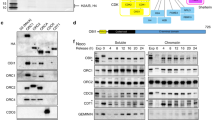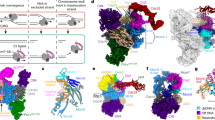Abstract
To maintain genome stability, DNA replication is strictly regulated to occur only once per cell cycle. In eukaryotes, the presence of ‘licensing proteins’ at replication origins during the G1 cell-cycle phase allows the formation of the pre-replicative complex1. The removal of licensing proteins from chromatin during the S phase ensures that origins fire only once per cell cycle1. Here we show that the CUL-4 ubiquitin ligase temporally restricts DNA-replication licensing in Caenorhabditis elegans. Inactivation of CUL-4 causes massive DNA re-replication, producing cells with up to 100C DNA content. The C. elegans orthologue of the replication-licensing factor Cdt1 (refs 2, 3) is required for DNA replication. C. elegans CDT-1 is present in G1-phase nuclei but disappears as cells enter S phase. In cells lacking CUL-4, CDT-1 levels fail to decrease during S phase and instead remain constant in the re-replicating cells. Removal of one genomic copy of cdt-1 suppresses the cul-4 re-replication phenotype. We propose that CUL-4 prevents aberrant re-initiation of DNA replication, at least in part, by facilitating the degradation of CDT-1.
This is a preview of subscription content, access via your institution
Access options
Subscribe to this journal
Receive 51 print issues and online access
$199.00 per year
only $3.90 per issue
Buy this article
- Purchase on Springer Link
- Instant access to full article PDF
Prices may be subject to local taxes which are calculated during checkout




Similar content being viewed by others
References
Blow, J. J. & Hodgson, B. Replication licensing—defining the proliferative state? Trends Cell Biol. 12, 72–78 (2002)
Nishitani, H., Lygerou, Z., Nishimoto, T. & Nurse, P. The Cdt1 protein is required to license DNA for replication in fission yeast. Nature 404, 625–628 (2000)
Maiorano, D., Moreau, J. & Mechali, M. XCDT1 is required for the assembly of pre-replicative complexes in Xenopus laevis. Nature 404, 622–625 (2000)
Nayak, S. et al. The Caenorhabditis elegans Skp1-related gene family: diverse functions in cell proliferation, morphogenesis, and meiosis. Curr. Biol. 12, 277–287 (2002)
Tyers, M. & Jorgensen, P. Proteolysis and the cell cycle: with this RING I do thee destroy. Curr. Opin. Genet. Dev. 10, 54–64 (2000)
Fire, A. et al. Potent and specific genetic interference by double-stranded RNA in Caenorhabditis elegans. Nature 391, 806–811 (1998)
Hedgecock, E. M., Culotti, J. G. & Hall, D. H. The unc-5, unc-6, and unc-40 genes guide circumferential migrations of pioneer axons and mesodermal cells on the epidermis in C. elegans. Neuron 4, 61–85 (1990)
Sulston, J. E. & Horvitz, H. R. Post-embryonic cell lineages of the nematode, Caenorhabditis elegans. Dev. Biol. 56, 110–156 (1977)
Seydoux, G. & Schedl, T. The germline in C. elegans: origins, proliferation, and silencing. Int. Rev. Cytol. 203, 139–185 (2001)
Lorson, M. A., Horvitz, H. R. & van den Heuvel, S. LIN-5 is a novel component of the spindle apparatus required for chromosome segregation and cleavage plane specification in Caenorhabditis elegans. J. Cell Biol. 148, 73–86 (2000)
Edgar, B. A. & Orr-Weaver, T. L. Endoreplication cell cycles: more for less. Cell 105, 297–306 (2001)
Hendzel, M. J. et al. Mitosis-specific phosphorylation of histone H3 initiates primarily within pericentromeric heterochromatin during G2 and spreads in an ordered fashion coincident with mitotic chromosome condensation. Chromosoma 106, 348–360 (1997)
Hong, Y., Roy, R. & Ambros, V. Developmental regulation of a cyclin-dependent kinase inhibitor controls postembryonic cell cycle progression in Caenorhabditis elegans. Development 125, 3585–3597 (1998)
Hedgecock, E. M. & White, J. G. Polyploid tissues in the nematode Caenorhabditis elegans. Dev. Biol. 107, 128–133 (1985)
Whittaker, A. J., Royzman, I. & Orr-Weaver, T. L. Drosophila double parked: a conserved, essential replication protein that colocalizes with the origin recognition complex and links DNA replication with mitosis and the down-regulation of S phase transcripts. Genes Dev. 14, 1765–1776 (2000)
Cimbora, D. M. & Groudine, M. The control of mammalian DNA replication: a brief history of space and timing. Cell 104, 643–646 (2001)
Tanaka, S. & Diffley, J. F. Interdependent nuclear accumulation of budding yeast Cdt1 and Mcm2-7 during G1 phase. Nature Cell Biol. 4, 198–207 (2002)
Wohlschlegel, J. A. et al. Inhibition of eukaryotic DNA replication by Geminin binding to Cdt1. Science 290, 2309–2312 (2000)
Edgar, L. G. & McGhee, J. D. DNA synthesis and the control of embryonic gene expression in C. elegans. Cell 53, 589–599 (1988)
Nishitani, H., Taraviras, S., Lygerou, Z. & Nishimoto, T. The human licensing factor for DNA replication Cdt1 accumulates in G1 and is destabilized after initiation of S-phase. J. Biol. Chem. 276, 44905–44911 (2001)
Praitis, V., Casey, E., Collar, D. & Austin, J. Creation of low-copy integrated transgenic lines in Caenorhabditis elegans. Genetics 157, 1217–1226 (2001)
Todorov, I. T., Attaran, A. & Kearsey, S. E. BM28, a human member of the MCM2-3-5 family, is displaced from chromatin during DNA replication. J. Cell Biol. 129, 1433–1445 (1995)
Tada, S., Li, A., Maiorano, D., Mechali, M. & Blow, J. J. Repression of origin assembly in metaphase depends on inhibition of RLF-B/Cdt1 by geminin. Nature Cell Biol. 3, 107–113 (2001)
Nguyen, V. Q., Co, C. & Li, J. J. Cyclin-dependent kinases prevent DNA re-replication through multiple mechanisms. Nature 411, 1068–1073 (2001)
Yanow, S. K., Lygerou, Z. & Nurse, P. Expression of Cdc18/Cdc6 and Cdt1 during G2 phase induces initiation of DNA replication. EMBO J. 20, 4648–4656 (2001)
Timmons, L. & Fire, A. Specific interference by ingested dsRNA. Nature 395, 854 (1998)
Altschul, S. F. et al. Gapped BLAST and PSI-BLAST: a new generation of protein database search programs. Nucleic Acids Res. 25, 3389–3402 (1997)
Koppen, M. et al. Cooperative regulation of AJM-1 controls junctional integrity in Caenorhabditis elegans epithelia. Nature Cell Biol. 3, 983–991 (2001)
Miller, D. M. & Shakes, D. C. in Caenorhabditis elegans: Modern Biological Analysis of an Organism (eds Epstein, H. F. & Shakes, D. C.) 365–394 (Academic Press, San Diego, 1995)
Feng, H. et al. CUL-2 is required for the G1-to-S phase transition and mitotic chromosome condensation in Caenorhabditis elegans. Nature Cell Biol. 1, 486–492 (1999)
Acknowledgements
We thank Y. Kohara, A. Fire, G. Seydoux, R. Roy and V. Ambros for reagents; the Caenorhabditis Genetics Center for nematode strains; R. Santurri for technical help; and H. Cai and P. Shen for critical reading of the manuscript. This work was supported by a grant from the National Institutes of Health to E.T.K.
Author information
Authors and Affiliations
Corresponding author
Ethics declarations
Competing interests
The authors declare that they have no competing financial interests.
Rights and permissions
About this article
Cite this article
Zhong, W., Feng, H., Santiago, F. et al. CUL-4 ubiquitin ligase maintains genome stability by restraining DNA-replication licensing. Nature 423, 885–889 (2003). https://doi.org/10.1038/nature01747
Received:
Accepted:
Published:
Issue Date:
DOI: https://doi.org/10.1038/nature01747
This article is cited by
-
DDB1- and CUL4-associated factor 8 plays a critical role in spermatogenesis
Frontiers of Medicine (2021)
-
The RepID–CRL4 ubiquitin ligase complex regulates metaphase to anaphase transition via BUB3 degradation
Nature Communications (2020)
-
Ubiquitin and the DNA double-strand break repair pathway
Genome Instability & Disease (2020)
-
The replication initiation determinant protein (RepID) modulates replication by recruiting CUL4 to chromatin
Nature Communications (2018)
-
Strategic role of the ubiquitin-dependent segregase p97 (VCP or Cdc48) in DNA replication
Chromosoma (2017)
Comments
By submitting a comment you agree to abide by our Terms and Community Guidelines. If you find something abusive or that does not comply with our terms or guidelines please flag it as inappropriate.



